Legal Guidelines for Clean Machine Ltd
VerifiedAdded on 2022/12/30
|12
|3587
|274
AI Summary
This report discusses the legal guidelines that Clean Machine Ltd, an organization supplying protective equipment, must follow in different scenarios. It covers the roles and responsibilities of the director, termination of employees, and resolving disputes with partners. The report emphasizes the importance of understanding legislative policies and code of conduct in Bedfordshire.
Contribute Materials
Your contribution can guide someone’s learning journey. Share your
documents today.
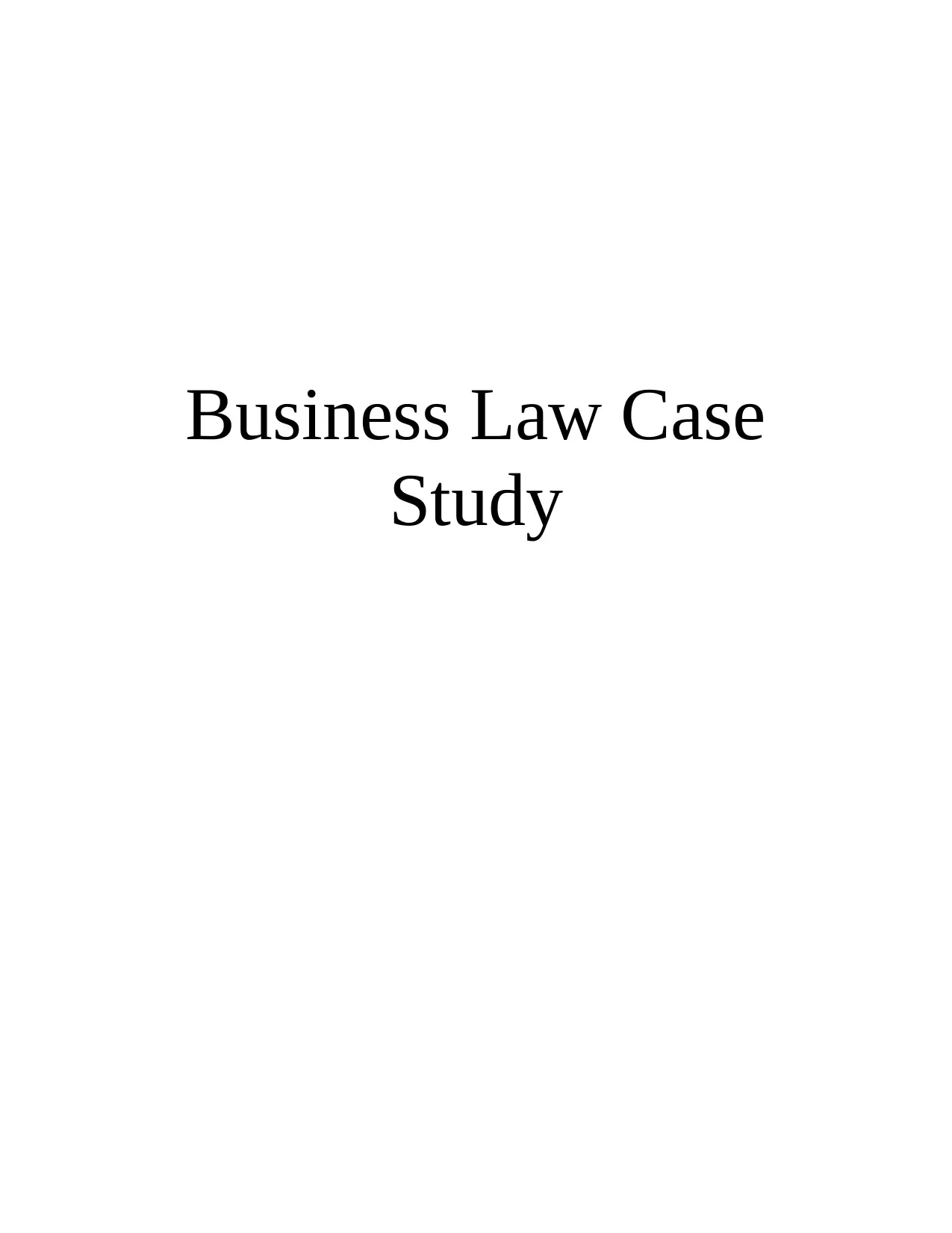
Business Law Case
Study
Study
Secure Best Marks with AI Grader
Need help grading? Try our AI Grader for instant feedback on your assignments.
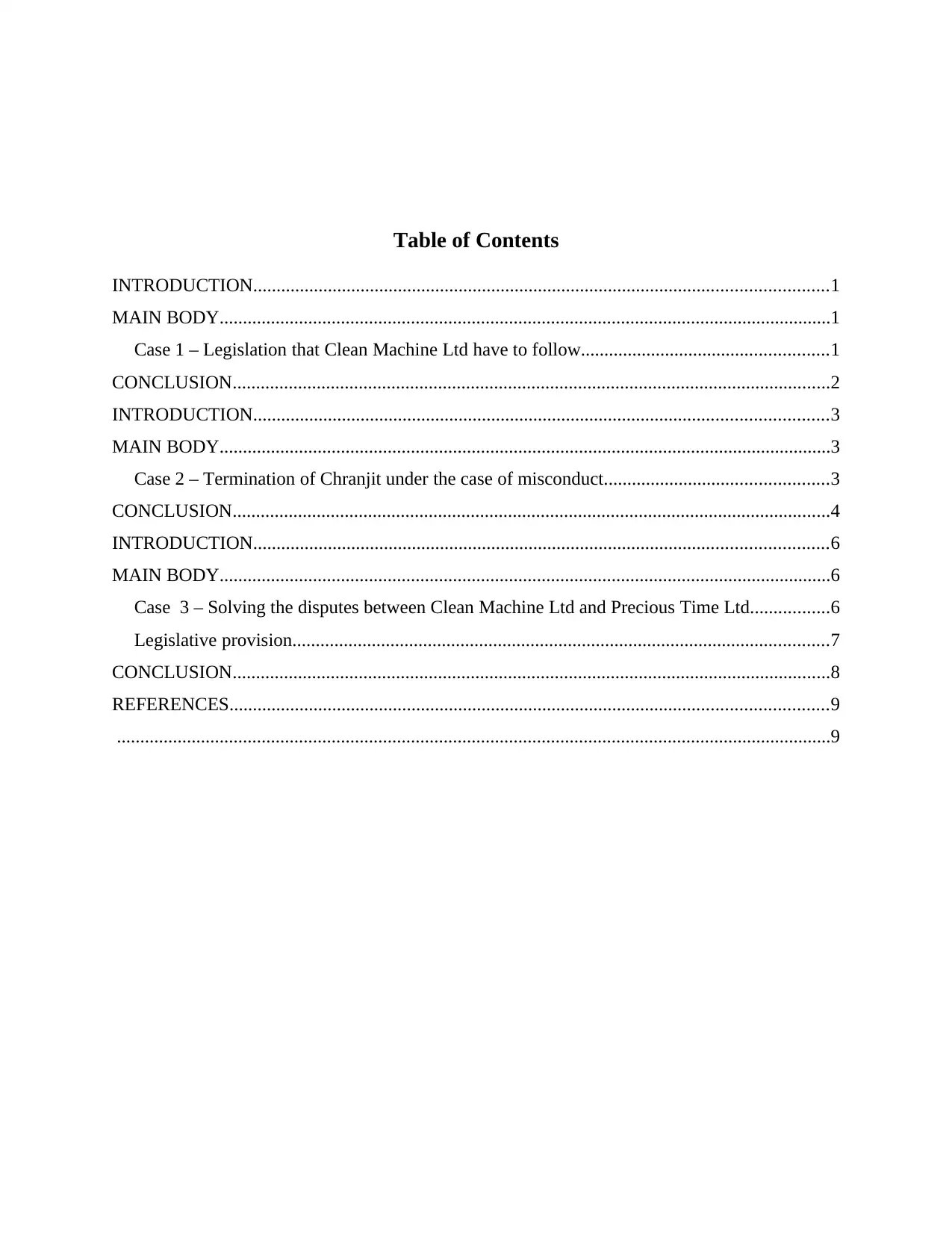
Table of Contents
INTRODUCTION...........................................................................................................................1
MAIN BODY...................................................................................................................................1
Case 1 – Legislation that Clean Machine Ltd have to follow.....................................................1
CONCLUSION................................................................................................................................2
INTRODUCTION...........................................................................................................................3
MAIN BODY...................................................................................................................................3
Case 2 – Termination of Chranjit under the case of misconduct................................................3
CONCLUSION................................................................................................................................4
INTRODUCTION...........................................................................................................................6
MAIN BODY...................................................................................................................................6
Case 3 – Solving the disputes between Clean Machine Ltd and Precious Time Ltd.................6
Legislative provision...................................................................................................................7
CONCLUSION................................................................................................................................8
REFERENCES................................................................................................................................9
.........................................................................................................................................................9
INTRODUCTION...........................................................................................................................1
MAIN BODY...................................................................................................................................1
Case 1 – Legislation that Clean Machine Ltd have to follow.....................................................1
CONCLUSION................................................................................................................................2
INTRODUCTION...........................................................................................................................3
MAIN BODY...................................................................................................................................3
Case 2 – Termination of Chranjit under the case of misconduct................................................3
CONCLUSION................................................................................................................................4
INTRODUCTION...........................................................................................................................6
MAIN BODY...................................................................................................................................6
Case 3 – Solving the disputes between Clean Machine Ltd and Precious Time Ltd.................6
Legislative provision...................................................................................................................7
CONCLUSION................................................................................................................................8
REFERENCES................................................................................................................................9
.........................................................................................................................................................9
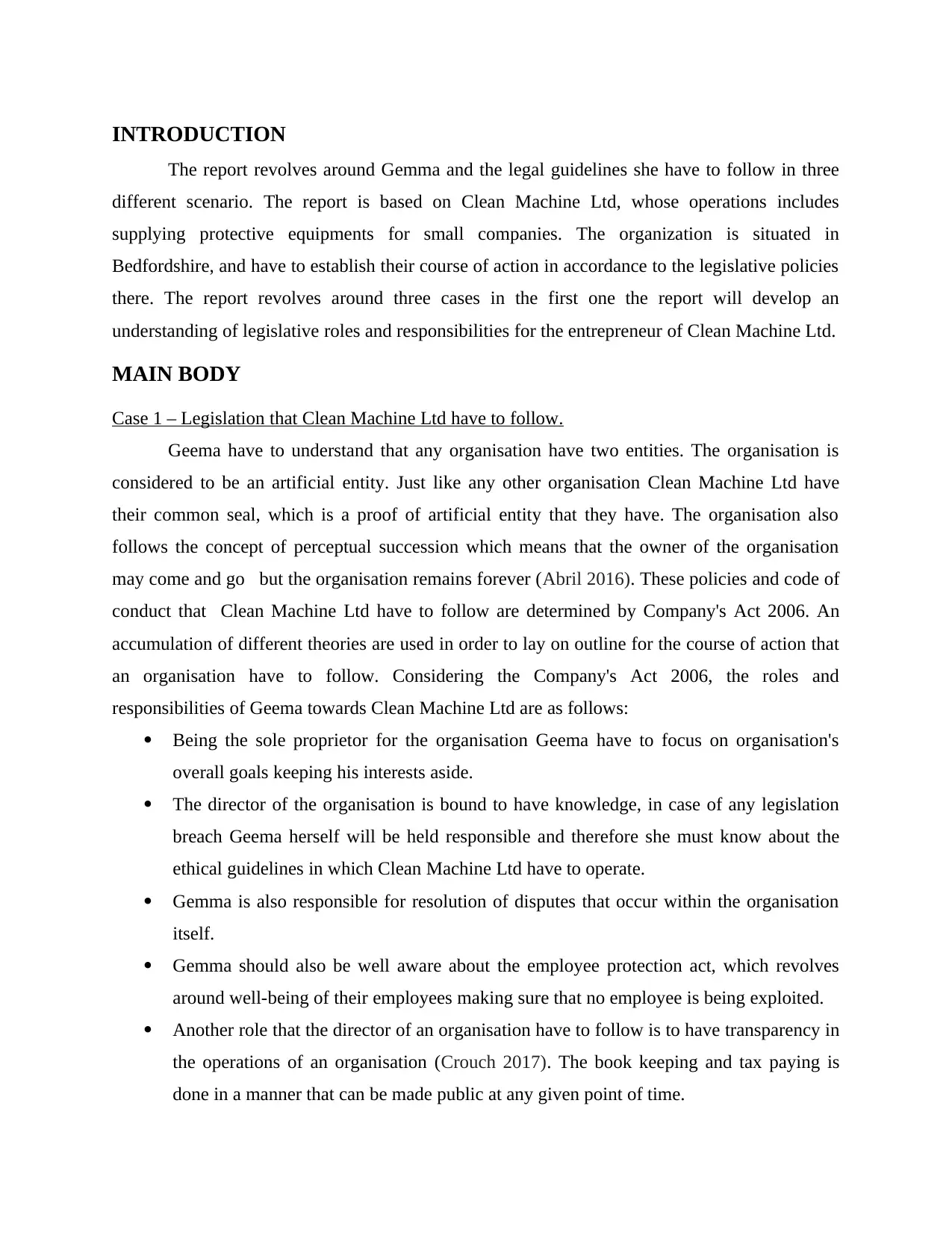
INTRODUCTION
The report revolves around Gemma and the legal guidelines she have to follow in three
different scenario. The report is based on Clean Machine Ltd, whose operations includes
supplying protective equipments for small companies. The organization is situated in
Bedfordshire, and have to establish their course of action in accordance to the legislative policies
there. The report revolves around three cases in the first one the report will develop an
understanding of legislative roles and responsibilities for the entrepreneur of Clean Machine Ltd.
MAIN BODY
Case 1 – Legislation that Clean Machine Ltd have to follow.
Geema have to understand that any organisation have two entities. The organisation is
considered to be an artificial entity. Just like any other organisation Clean Machine Ltd have
their common seal, which is a proof of artificial entity that they have. The organisation also
follows the concept of perceptual succession which means that the owner of the organisation
may come and go but the organisation remains forever (Abril 2016). These policies and code of
conduct that Clean Machine Ltd have to follow are determined by Company's Act 2006. An
accumulation of different theories are used in order to lay on outline for the course of action that
an organisation have to follow. Considering the Company's Act 2006, the roles and
responsibilities of Geema towards Clean Machine Ltd are as follows:
Being the sole proprietor for the organisation Geema have to focus on organisation's
overall goals keeping his interests aside.
The director of the organisation is bound to have knowledge, in case of any legislation
breach Geema herself will be held responsible and therefore she must know about the
ethical guidelines in which Clean Machine Ltd have to operate.
Gemma is also responsible for resolution of disputes that occur within the organisation
itself.
Gemma should also be well aware about the employee protection act, which revolves
around well-being of their employees making sure that no employee is being exploited.
Another role that the director of an organisation have to follow is to have transparency in
the operations of an organisation (Crouch 2017). The book keeping and tax paying is
done in a manner that can be made public at any given point of time.
The report revolves around Gemma and the legal guidelines she have to follow in three
different scenario. The report is based on Clean Machine Ltd, whose operations includes
supplying protective equipments for small companies. The organization is situated in
Bedfordshire, and have to establish their course of action in accordance to the legislative policies
there. The report revolves around three cases in the first one the report will develop an
understanding of legislative roles and responsibilities for the entrepreneur of Clean Machine Ltd.
MAIN BODY
Case 1 – Legislation that Clean Machine Ltd have to follow.
Geema have to understand that any organisation have two entities. The organisation is
considered to be an artificial entity. Just like any other organisation Clean Machine Ltd have
their common seal, which is a proof of artificial entity that they have. The organisation also
follows the concept of perceptual succession which means that the owner of the organisation
may come and go but the organisation remains forever (Abril 2016). These policies and code of
conduct that Clean Machine Ltd have to follow are determined by Company's Act 2006. An
accumulation of different theories are used in order to lay on outline for the course of action that
an organisation have to follow. Considering the Company's Act 2006, the roles and
responsibilities of Geema towards Clean Machine Ltd are as follows:
Being the sole proprietor for the organisation Geema have to focus on organisation's
overall goals keeping his interests aside.
The director of the organisation is bound to have knowledge, in case of any legislation
breach Geema herself will be held responsible and therefore she must know about the
ethical guidelines in which Clean Machine Ltd have to operate.
Gemma is also responsible for resolution of disputes that occur within the organisation
itself.
Gemma should also be well aware about the employee protection act, which revolves
around well-being of their employees making sure that no employee is being exploited.
Another role that the director of an organisation have to follow is to have transparency in
the operations of an organisation (Crouch 2017). The book keeping and tax paying is
done in a manner that can be made public at any given point of time.
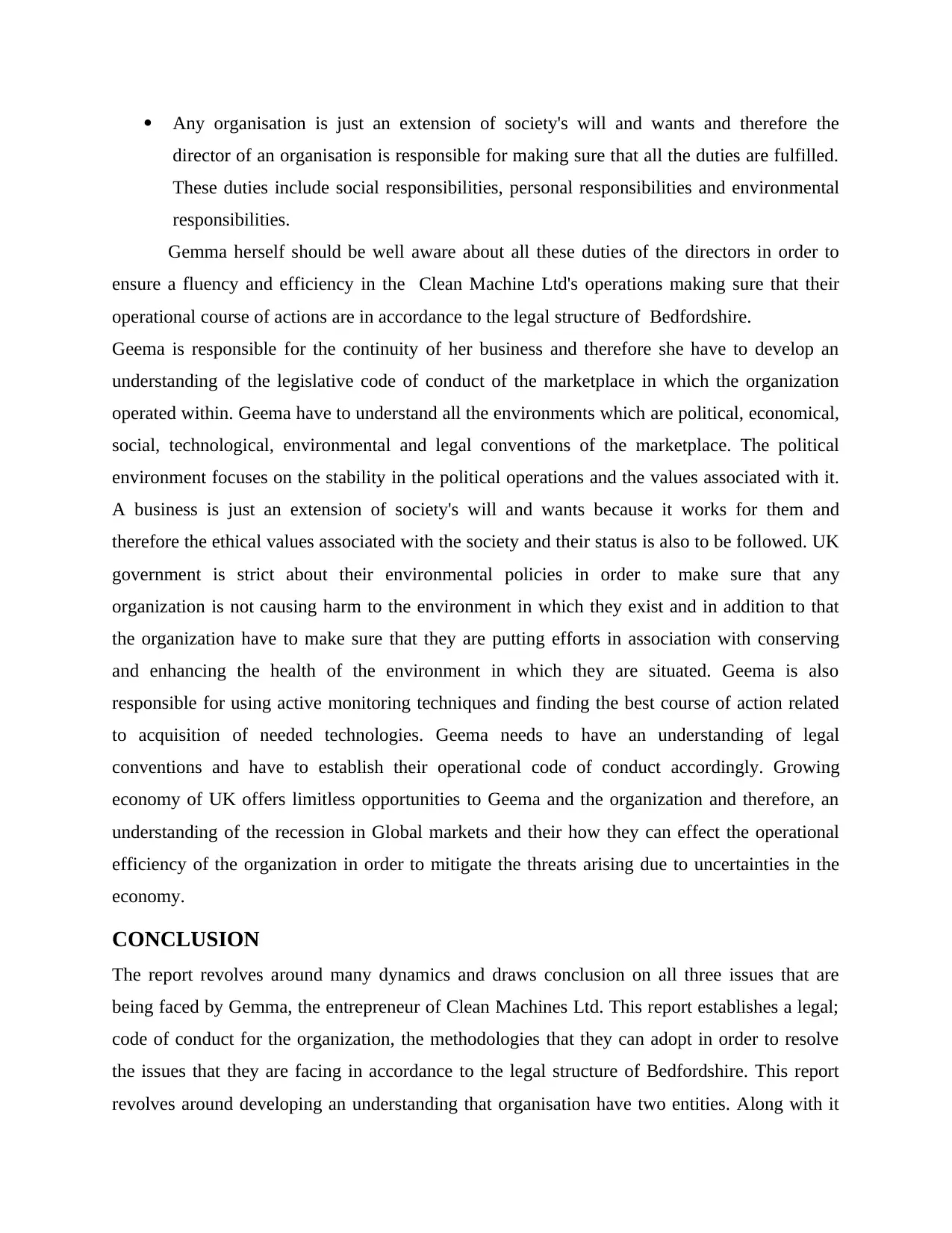
Any organisation is just an extension of society's will and wants and therefore the
director of an organisation is responsible for making sure that all the duties are fulfilled.
These duties include social responsibilities, personal responsibilities and environmental
responsibilities.
Gemma herself should be well aware about all these duties of the directors in order to
ensure a fluency and efficiency in the Clean Machine Ltd's operations making sure that their
operational course of actions are in accordance to the legal structure of Bedfordshire.
Geema is responsible for the continuity of her business and therefore she have to develop an
understanding of the legislative code of conduct of the marketplace in which the organization
operated within. Geema have to understand all the environments which are political, economical,
social, technological, environmental and legal conventions of the marketplace. The political
environment focuses on the stability in the political operations and the values associated with it.
A business is just an extension of society's will and wants because it works for them and
therefore the ethical values associated with the society and their status is also to be followed. UK
government is strict about their environmental policies in order to make sure that any
organization is not causing harm to the environment in which they exist and in addition to that
the organization have to make sure that they are putting efforts in association with conserving
and enhancing the health of the environment in which they are situated. Geema is also
responsible for using active monitoring techniques and finding the best course of action related
to acquisition of needed technologies. Geema needs to have an understanding of legal
conventions and have to establish their operational code of conduct accordingly. Growing
economy of UK offers limitless opportunities to Geema and the organization and therefore, an
understanding of the recession in Global markets and their how they can effect the operational
efficiency of the organization in order to mitigate the threats arising due to uncertainties in the
economy.
CONCLUSION
The report revolves around many dynamics and draws conclusion on all three issues that are
being faced by Gemma, the entrepreneur of Clean Machines Ltd. This report establishes a legal;
code of conduct for the organization, the methodologies that they can adopt in order to resolve
the issues that they are facing in accordance to the legal structure of Bedfordshire. This report
revolves around developing an understanding that organisation have two entities. Along with it
director of an organisation is responsible for making sure that all the duties are fulfilled.
These duties include social responsibilities, personal responsibilities and environmental
responsibilities.
Gemma herself should be well aware about all these duties of the directors in order to
ensure a fluency and efficiency in the Clean Machine Ltd's operations making sure that their
operational course of actions are in accordance to the legal structure of Bedfordshire.
Geema is responsible for the continuity of her business and therefore she have to develop an
understanding of the legislative code of conduct of the marketplace in which the organization
operated within. Geema have to understand all the environments which are political, economical,
social, technological, environmental and legal conventions of the marketplace. The political
environment focuses on the stability in the political operations and the values associated with it.
A business is just an extension of society's will and wants because it works for them and
therefore the ethical values associated with the society and their status is also to be followed. UK
government is strict about their environmental policies in order to make sure that any
organization is not causing harm to the environment in which they exist and in addition to that
the organization have to make sure that they are putting efforts in association with conserving
and enhancing the health of the environment in which they are situated. Geema is also
responsible for using active monitoring techniques and finding the best course of action related
to acquisition of needed technologies. Geema needs to have an understanding of legal
conventions and have to establish their operational code of conduct accordingly. Growing
economy of UK offers limitless opportunities to Geema and the organization and therefore, an
understanding of the recession in Global markets and their how they can effect the operational
efficiency of the organization in order to mitigate the threats arising due to uncertainties in the
economy.
CONCLUSION
The report revolves around many dynamics and draws conclusion on all three issues that are
being faced by Gemma, the entrepreneur of Clean Machines Ltd. This report establishes a legal;
code of conduct for the organization, the methodologies that they can adopt in order to resolve
the issues that they are facing in accordance to the legal structure of Bedfordshire. This report
revolves around developing an understanding that organisation have two entities. Along with it
Secure Best Marks with AI Grader
Need help grading? Try our AI Grader for instant feedback on your assignments.

Gemma have to develop an understanding that there are different types of organisations and there
are legal guidelines associated with every one of them like Company's Act and partnership act.
are legal guidelines associated with every one of them like Company's Act and partnership act.
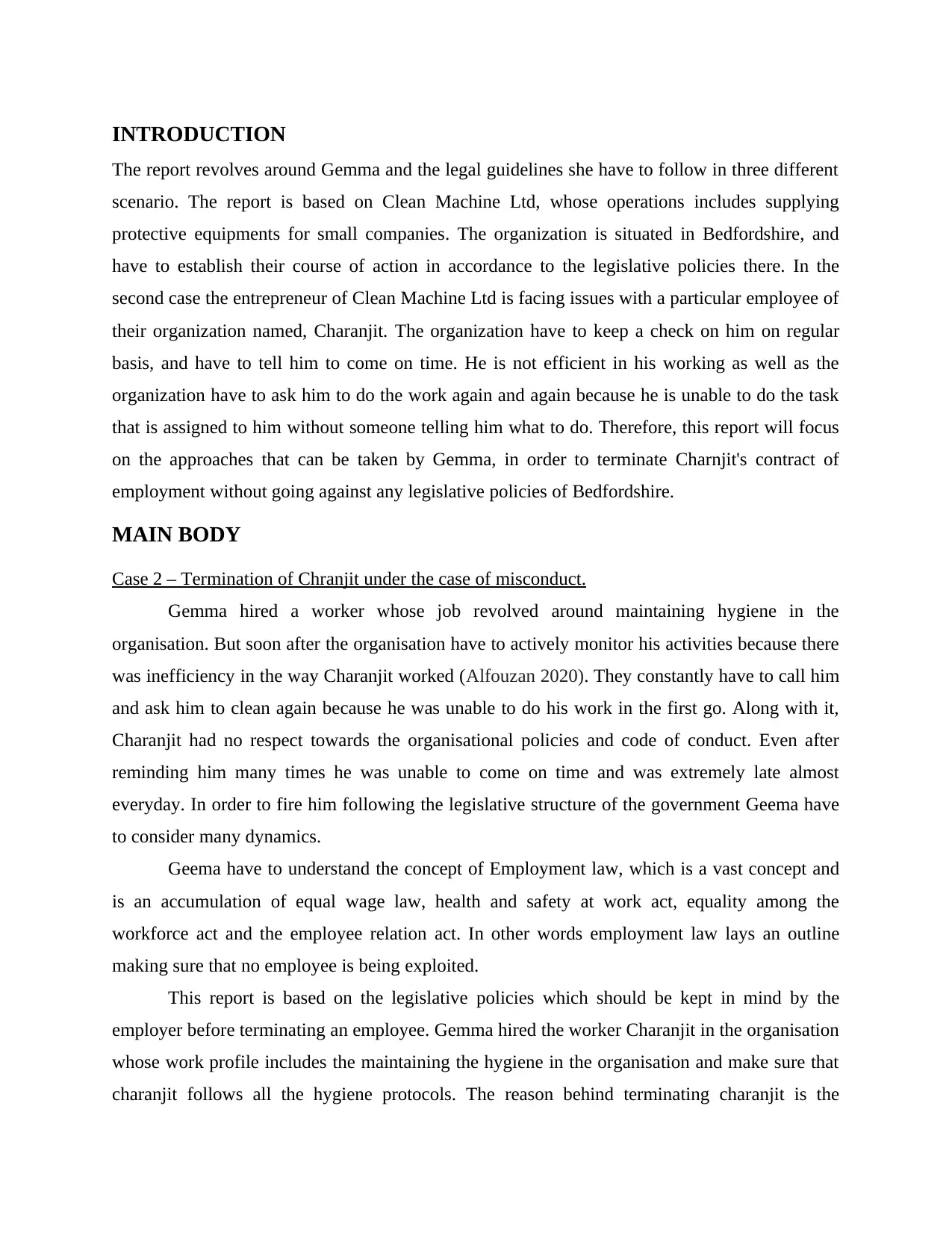
INTRODUCTION
The report revolves around Gemma and the legal guidelines she have to follow in three different
scenario. The report is based on Clean Machine Ltd, whose operations includes supplying
protective equipments for small companies. The organization is situated in Bedfordshire, and
have to establish their course of action in accordance to the legislative policies there. In the
second case the entrepreneur of Clean Machine Ltd is facing issues with a particular employee of
their organization named, Charanjit. The organization have to keep a check on him on regular
basis, and have to tell him to come on time. He is not efficient in his working as well as the
organization have to ask him to do the work again and again because he is unable to do the task
that is assigned to him without someone telling him what to do. Therefore, this report will focus
on the approaches that can be taken by Gemma, in order to terminate Charnjit's contract of
employment without going against any legislative policies of Bedfordshire.
MAIN BODY
Case 2 – Termination of Chranjit under the case of misconduct.
Gemma hired a worker whose job revolved around maintaining hygiene in the
organisation. But soon after the organisation have to actively monitor his activities because there
was inefficiency in the way Charanjit worked (Alfouzan 2020). They constantly have to call him
and ask him to clean again because he was unable to do his work in the first go. Along with it,
Charanjit had no respect towards the organisational policies and code of conduct. Even after
reminding him many times he was unable to come on time and was extremely late almost
everyday. In order to fire him following the legislative structure of the government Geema have
to consider many dynamics.
Geema have to understand the concept of Employment law, which is a vast concept and
is an accumulation of equal wage law, health and safety at work act, equality among the
workforce act and the employee relation act. In other words employment law lays an outline
making sure that no employee is being exploited.
This report is based on the legislative policies which should be kept in mind by the
employer before terminating an employee. Gemma hired the worker Charanjit in the organisation
whose work profile includes the maintaining the hygiene in the organisation and make sure that
charanjit follows all the hygiene protocols. The reason behind terminating charanjit is the
The report revolves around Gemma and the legal guidelines she have to follow in three different
scenario. The report is based on Clean Machine Ltd, whose operations includes supplying
protective equipments for small companies. The organization is situated in Bedfordshire, and
have to establish their course of action in accordance to the legislative policies there. In the
second case the entrepreneur of Clean Machine Ltd is facing issues with a particular employee of
their organization named, Charanjit. The organization have to keep a check on him on regular
basis, and have to tell him to come on time. He is not efficient in his working as well as the
organization have to ask him to do the work again and again because he is unable to do the task
that is assigned to him without someone telling him what to do. Therefore, this report will focus
on the approaches that can be taken by Gemma, in order to terminate Charnjit's contract of
employment without going against any legislative policies of Bedfordshire.
MAIN BODY
Case 2 – Termination of Chranjit under the case of misconduct.
Gemma hired a worker whose job revolved around maintaining hygiene in the
organisation. But soon after the organisation have to actively monitor his activities because there
was inefficiency in the way Charanjit worked (Alfouzan 2020). They constantly have to call him
and ask him to clean again because he was unable to do his work in the first go. Along with it,
Charanjit had no respect towards the organisational policies and code of conduct. Even after
reminding him many times he was unable to come on time and was extremely late almost
everyday. In order to fire him following the legislative structure of the government Geema have
to consider many dynamics.
Geema have to understand the concept of Employment law, which is a vast concept and
is an accumulation of equal wage law, health and safety at work act, equality among the
workforce act and the employee relation act. In other words employment law lays an outline
making sure that no employee is being exploited.
This report is based on the legislative policies which should be kept in mind by the
employer before terminating an employee. Gemma hired the worker Charanjit in the organisation
whose work profile includes the maintaining the hygiene in the organisation and make sure that
charanjit follows all the hygiene protocols. The reason behind terminating charanjit is the
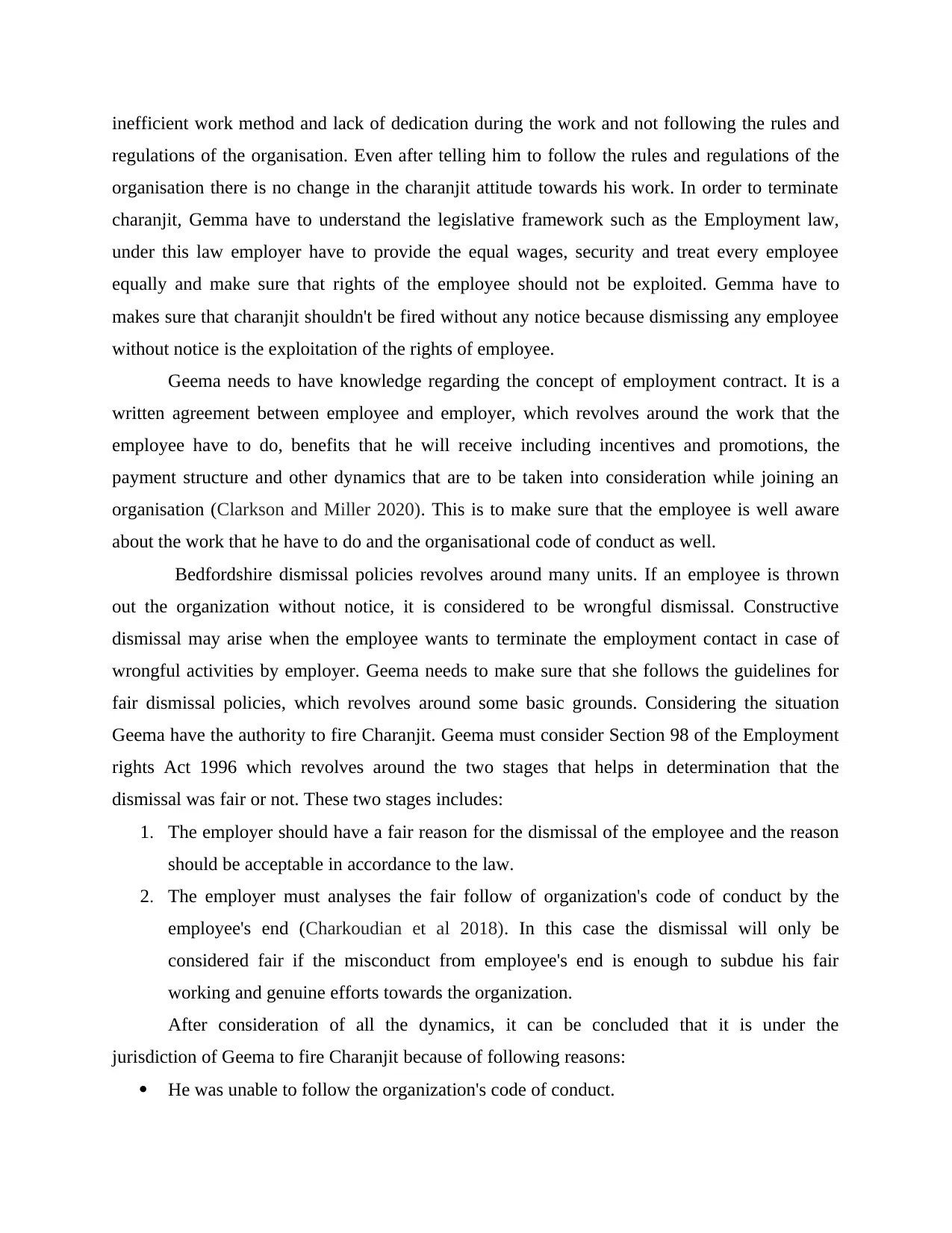
inefficient work method and lack of dedication during the work and not following the rules and
regulations of the organisation. Even after telling him to follow the rules and regulations of the
organisation there is no change in the charanjit attitude towards his work. In order to terminate
charanjit, Gemma have to understand the legislative framework such as the Employment law,
under this law employer have to provide the equal wages, security and treat every employee
equally and make sure that rights of the employee should not be exploited. Gemma have to
makes sure that charanjit shouldn't be fired without any notice because dismissing any employee
without notice is the exploitation of the rights of employee.
Geema needs to have knowledge regarding the concept of employment contract. It is a
written agreement between employee and employer, which revolves around the work that the
employee have to do, benefits that he will receive including incentives and promotions, the
payment structure and other dynamics that are to be taken into consideration while joining an
organisation (Clarkson and Miller 2020). This is to make sure that the employee is well aware
about the work that he have to do and the organisational code of conduct as well.
Bedfordshire dismissal policies revolves around many units. If an employee is thrown
out the organization without notice, it is considered to be wrongful dismissal. Constructive
dismissal may arise when the employee wants to terminate the employment contact in case of
wrongful activities by employer. Geema needs to make sure that she follows the guidelines for
fair dismissal policies, which revolves around some basic grounds. Considering the situation
Geema have the authority to fire Charanjit. Geema must consider Section 98 of the Employment
rights Act 1996 which revolves around the two stages that helps in determination that the
dismissal was fair or not. These two stages includes:
1. The employer should have a fair reason for the dismissal of the employee and the reason
should be acceptable in accordance to the law.
2. The employer must analyses the fair follow of organization's code of conduct by the
employee's end (Charkoudian et al 2018). In this case the dismissal will only be
considered fair if the misconduct from employee's end is enough to subdue his fair
working and genuine efforts towards the organization.
After consideration of all the dynamics, it can be concluded that it is under the
jurisdiction of Geema to fire Charanjit because of following reasons:
He was unable to follow the organization's code of conduct.
regulations of the organisation. Even after telling him to follow the rules and regulations of the
organisation there is no change in the charanjit attitude towards his work. In order to terminate
charanjit, Gemma have to understand the legislative framework such as the Employment law,
under this law employer have to provide the equal wages, security and treat every employee
equally and make sure that rights of the employee should not be exploited. Gemma have to
makes sure that charanjit shouldn't be fired without any notice because dismissing any employee
without notice is the exploitation of the rights of employee.
Geema needs to have knowledge regarding the concept of employment contract. It is a
written agreement between employee and employer, which revolves around the work that the
employee have to do, benefits that he will receive including incentives and promotions, the
payment structure and other dynamics that are to be taken into consideration while joining an
organisation (Clarkson and Miller 2020). This is to make sure that the employee is well aware
about the work that he have to do and the organisational code of conduct as well.
Bedfordshire dismissal policies revolves around many units. If an employee is thrown
out the organization without notice, it is considered to be wrongful dismissal. Constructive
dismissal may arise when the employee wants to terminate the employment contact in case of
wrongful activities by employer. Geema needs to make sure that she follows the guidelines for
fair dismissal policies, which revolves around some basic grounds. Considering the situation
Geema have the authority to fire Charanjit. Geema must consider Section 98 of the Employment
rights Act 1996 which revolves around the two stages that helps in determination that the
dismissal was fair or not. These two stages includes:
1. The employer should have a fair reason for the dismissal of the employee and the reason
should be acceptable in accordance to the law.
2. The employer must analyses the fair follow of organization's code of conduct by the
employee's end (Charkoudian et al 2018). In this case the dismissal will only be
considered fair if the misconduct from employee's end is enough to subdue his fair
working and genuine efforts towards the organization.
After consideration of all the dynamics, it can be concluded that it is under the
jurisdiction of Geema to fire Charanjit because of following reasons:
He was unable to follow the organization's code of conduct.
Paraphrase This Document
Need a fresh take? Get an instant paraphrase of this document with our AI Paraphraser

He was not able to satisfy the conditions that he signed up for contract, which I turns
means that there were misconduct from his end, exploiting the terms and conditions that
he legally signed up for in the contract.
He was not efficient in his actions and the organization had to put efforts by 5hemseloves
in making sure that the job is done.
Knowingly or unknowingly he disrespected the policies of the organization as well as the
terms and conditions of his employment contract and therefore his dismissal would be
considered a fair dismissal.
CONCLUSION
In order to establish an outline for termination of Charanjit, Gemma have tyo know about
Employment relation Act where the employer have the authority to terminate any employee in
case of any misconduct from his side. The policy is based on certain grounds, in case of
grievance misconduct the employer have the right to terminate the employee without any notice
period as well.
means that there were misconduct from his end, exploiting the terms and conditions that
he legally signed up for in the contract.
He was not efficient in his actions and the organization had to put efforts by 5hemseloves
in making sure that the job is done.
Knowingly or unknowingly he disrespected the policies of the organization as well as the
terms and conditions of his employment contract and therefore his dismissal would be
considered a fair dismissal.
CONCLUSION
In order to establish an outline for termination of Charanjit, Gemma have tyo know about
Employment relation Act where the employer have the authority to terminate any employee in
case of any misconduct from his side. The policy is based on certain grounds, in case of
grievance misconduct the employer have the right to terminate the employee without any notice
period as well.
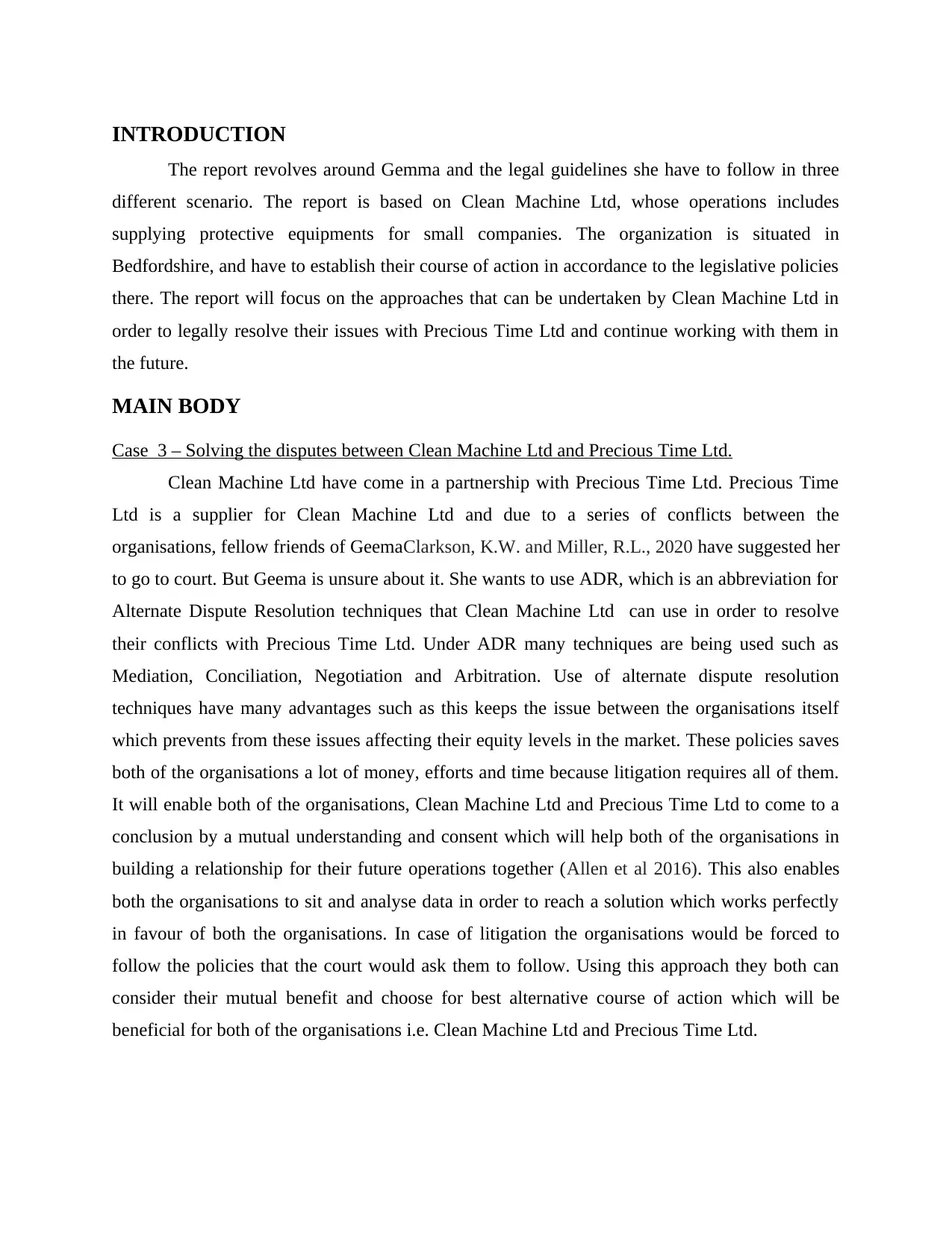
INTRODUCTION
The report revolves around Gemma and the legal guidelines she have to follow in three
different scenario. The report is based on Clean Machine Ltd, whose operations includes
supplying protective equipments for small companies. The organization is situated in
Bedfordshire, and have to establish their course of action in accordance to the legislative policies
there. The report will focus on the approaches that can be undertaken by Clean Machine Ltd in
order to legally resolve their issues with Precious Time Ltd and continue working with them in
the future.
MAIN BODY
Case 3 – Solving the disputes between Clean Machine Ltd and Precious Time Ltd.
Clean Machine Ltd have come in a partnership with Precious Time Ltd. Precious Time
Ltd is a supplier for Clean Machine Ltd and due to a series of conflicts between the
organisations, fellow friends of GeemaClarkson, K.W. and Miller, R.L., 2020 have suggested her
to go to court. But Geema is unsure about it. She wants to use ADR, which is an abbreviation for
Alternate Dispute Resolution techniques that Clean Machine Ltd can use in order to resolve
their conflicts with Precious Time Ltd. Under ADR many techniques are being used such as
Mediation, Conciliation, Negotiation and Arbitration. Use of alternate dispute resolution
techniques have many advantages such as this keeps the issue between the organisations itself
which prevents from these issues affecting their equity levels in the market. These policies saves
both of the organisations a lot of money, efforts and time because litigation requires all of them.
It will enable both of the organisations, Clean Machine Ltd and Precious Time Ltd to come to a
conclusion by a mutual understanding and consent which will help both of the organisations in
building a relationship for their future operations together (Allen et al 2016). This also enables
both the organisations to sit and analyse data in order to reach a solution which works perfectly
in favour of both the organisations. In case of litigation the organisations would be forced to
follow the policies that the court would ask them to follow. Using this approach they both can
consider their mutual benefit and choose for best alternative course of action which will be
beneficial for both of the organisations i.e. Clean Machine Ltd and Precious Time Ltd.
The report revolves around Gemma and the legal guidelines she have to follow in three
different scenario. The report is based on Clean Machine Ltd, whose operations includes
supplying protective equipments for small companies. The organization is situated in
Bedfordshire, and have to establish their course of action in accordance to the legislative policies
there. The report will focus on the approaches that can be undertaken by Clean Machine Ltd in
order to legally resolve their issues with Precious Time Ltd and continue working with them in
the future.
MAIN BODY
Case 3 – Solving the disputes between Clean Machine Ltd and Precious Time Ltd.
Clean Machine Ltd have come in a partnership with Precious Time Ltd. Precious Time
Ltd is a supplier for Clean Machine Ltd and due to a series of conflicts between the
organisations, fellow friends of GeemaClarkson, K.W. and Miller, R.L., 2020 have suggested her
to go to court. But Geema is unsure about it. She wants to use ADR, which is an abbreviation for
Alternate Dispute Resolution techniques that Clean Machine Ltd can use in order to resolve
their conflicts with Precious Time Ltd. Under ADR many techniques are being used such as
Mediation, Conciliation, Negotiation and Arbitration. Use of alternate dispute resolution
techniques have many advantages such as this keeps the issue between the organisations itself
which prevents from these issues affecting their equity levels in the market. These policies saves
both of the organisations a lot of money, efforts and time because litigation requires all of them.
It will enable both of the organisations, Clean Machine Ltd and Precious Time Ltd to come to a
conclusion by a mutual understanding and consent which will help both of the organisations in
building a relationship for their future operations together (Allen et al 2016). This also enables
both the organisations to sit and analyse data in order to reach a solution which works perfectly
in favour of both the organisations. In case of litigation the organisations would be forced to
follow the policies that the court would ask them to follow. Using this approach they both can
consider their mutual benefit and choose for best alternative course of action which will be
beneficial for both of the organisations i.e. Clean Machine Ltd and Precious Time Ltd.
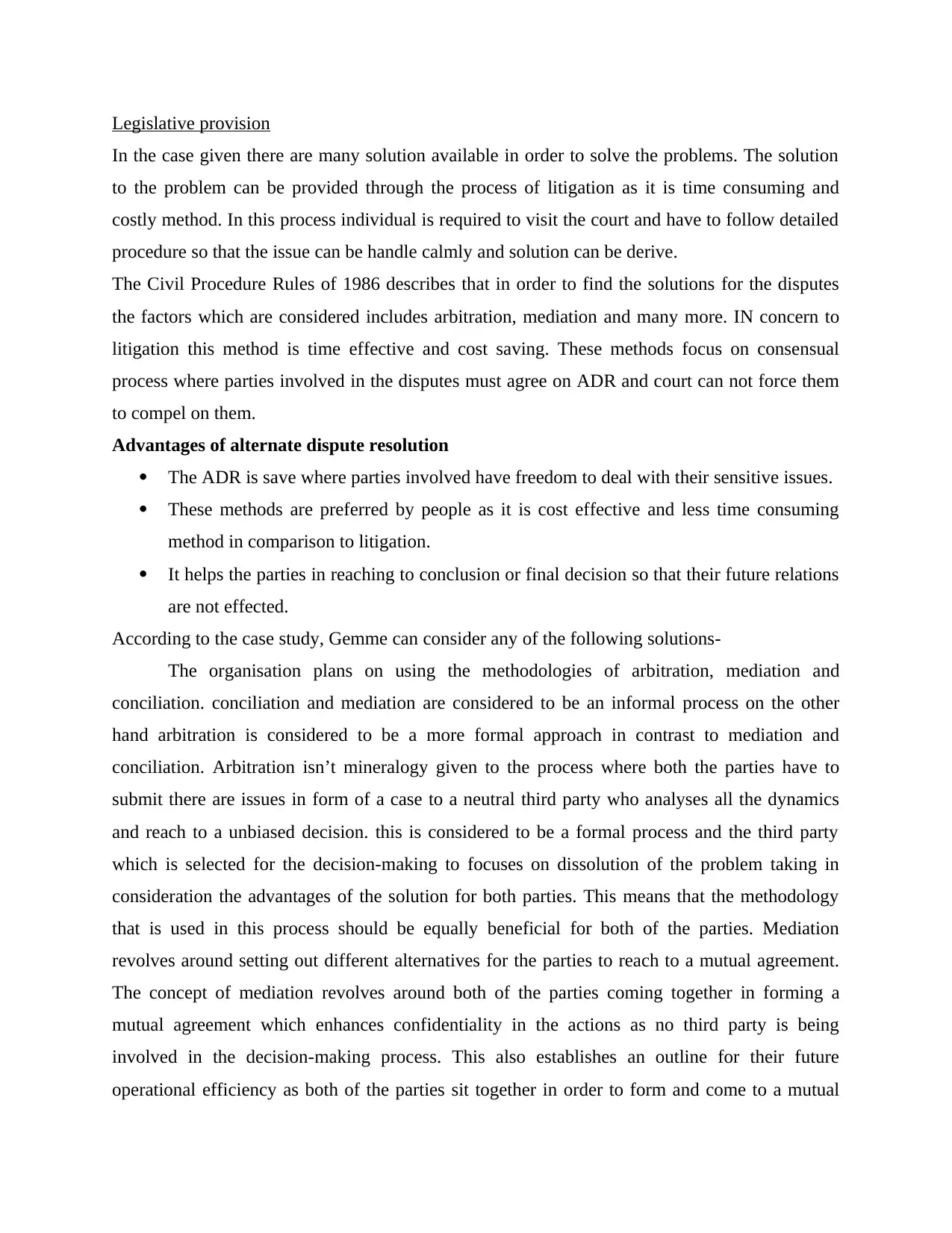
Legislative provision
In the case given there are many solution available in order to solve the problems. The solution
to the problem can be provided through the process of litigation as it is time consuming and
costly method. In this process individual is required to visit the court and have to follow detailed
procedure so that the issue can be handle calmly and solution can be derive.
The Civil Procedure Rules of 1986 describes that in order to find the solutions for the disputes
the factors which are considered includes arbitration, mediation and many more. IN concern to
litigation this method is time effective and cost saving. These methods focus on consensual
process where parties involved in the disputes must agree on ADR and court can not force them
to compel on them.
Advantages of alternate dispute resolution
The ADR is save where parties involved have freedom to deal with their sensitive issues.
These methods are preferred by people as it is cost effective and less time consuming
method in comparison to litigation.
It helps the parties in reaching to conclusion or final decision so that their future relations
are not effected.
According to the case study, Gemme can consider any of the following solutions-
The organisation plans on using the methodologies of arbitration, mediation and
conciliation. conciliation and mediation are considered to be an informal process on the other
hand arbitration is considered to be a more formal approach in contrast to mediation and
conciliation. Arbitration isn’t mineralogy given to the process where both the parties have to
submit there are issues in form of a case to a neutral third party who analyses all the dynamics
and reach to a unbiased decision. this is considered to be a formal process and the third party
which is selected for the decision-making to focuses on dissolution of the problem taking in
consideration the advantages of the solution for both parties. This means that the methodology
that is used in this process should be equally beneficial for both of the parties. Mediation
revolves around setting out different alternatives for the parties to reach to a mutual agreement.
The concept of mediation revolves around both of the parties coming together in forming a
mutual agreement which enhances confidentiality in the actions as no third party is being
involved in the decision-making process. This also establishes an outline for their future
operational efficiency as both of the parties sit together in order to form and come to a mutual
In the case given there are many solution available in order to solve the problems. The solution
to the problem can be provided through the process of litigation as it is time consuming and
costly method. In this process individual is required to visit the court and have to follow detailed
procedure so that the issue can be handle calmly and solution can be derive.
The Civil Procedure Rules of 1986 describes that in order to find the solutions for the disputes
the factors which are considered includes arbitration, mediation and many more. IN concern to
litigation this method is time effective and cost saving. These methods focus on consensual
process where parties involved in the disputes must agree on ADR and court can not force them
to compel on them.
Advantages of alternate dispute resolution
The ADR is save where parties involved have freedom to deal with their sensitive issues.
These methods are preferred by people as it is cost effective and less time consuming
method in comparison to litigation.
It helps the parties in reaching to conclusion or final decision so that their future relations
are not effected.
According to the case study, Gemme can consider any of the following solutions-
The organisation plans on using the methodologies of arbitration, mediation and
conciliation. conciliation and mediation are considered to be an informal process on the other
hand arbitration is considered to be a more formal approach in contrast to mediation and
conciliation. Arbitration isn’t mineralogy given to the process where both the parties have to
submit there are issues in form of a case to a neutral third party who analyses all the dynamics
and reach to a unbiased decision. this is considered to be a formal process and the third party
which is selected for the decision-making to focuses on dissolution of the problem taking in
consideration the advantages of the solution for both parties. This means that the methodology
that is used in this process should be equally beneficial for both of the parties. Mediation
revolves around setting out different alternatives for the parties to reach to a mutual agreement.
The concept of mediation revolves around both of the parties coming together in forming a
mutual agreement which enhances confidentiality in the actions as no third party is being
involved in the decision-making process. This also establishes an outline for their future
operational efficiency as both of the parties sit together in order to form and come to a mutual
Secure Best Marks with AI Grader
Need help grading? Try our AI Grader for instant feedback on your assignments.

conclusion which strengthens their relationship in terms of future working together. The
methodology of conciliation revolves around taking assistance of a neutral third party which
provides recommendations in the process of decision-making process to come to a mutual
agreement. The rule of this third party is just of an advisory body which give recommendations
in the alternative courses of action using which the two parties can come to a mutual agreement,
it is the choice of both of the parties to follow their recommendation or not. Despite all the
differences in these approaches the main goal is always dispute resolution and making sure that
the issues that the two parties are facing are being resolved.
CONCLUSION
Gemma have to study about ADR as well which is an abbreviation for Alternate Dispute
Resolution. The law revolves around different methodologies that can be undertaken by Gemma
which are Mediation, Conciliation, Negotiation and Arbitration. Gemma can go for either of
these techniques in order to resolve their disputes with Precious Time Ltd.
Gemme has signed the contact with Precious time limited who are the suppliers of Clean
Machine Limited. There is some kind of problem or issue between both the companies where
Gemme's friend has advised her to take the Precious time limited to court but has not taken any
step because she was not sure as she don't know and facts.
methodology of conciliation revolves around taking assistance of a neutral third party which
provides recommendations in the process of decision-making process to come to a mutual
agreement. The rule of this third party is just of an advisory body which give recommendations
in the alternative courses of action using which the two parties can come to a mutual agreement,
it is the choice of both of the parties to follow their recommendation or not. Despite all the
differences in these approaches the main goal is always dispute resolution and making sure that
the issues that the two parties are facing are being resolved.
CONCLUSION
Gemma have to study about ADR as well which is an abbreviation for Alternate Dispute
Resolution. The law revolves around different methodologies that can be undertaken by Gemma
which are Mediation, Conciliation, Negotiation and Arbitration. Gemma can go for either of
these techniques in order to resolve their disputes with Precious Time Ltd.
Gemme has signed the contact with Precious time limited who are the suppliers of Clean
Machine Limited. There is some kind of problem or issue between both the companies where
Gemme's friend has advised her to take the Precious time limited to court but has not taken any
step because she was not sure as she don't know and facts.
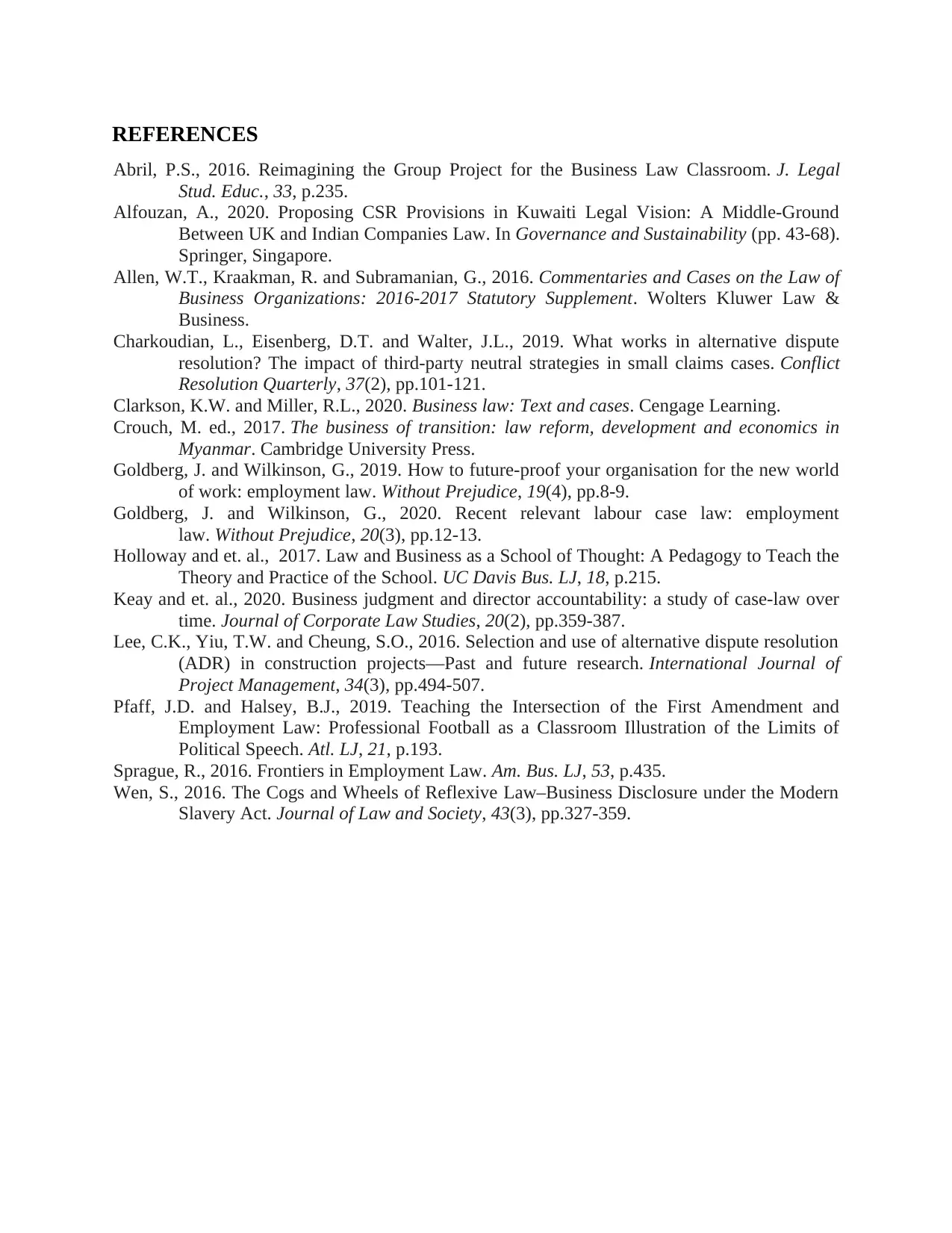
REFERENCES
Abril, P.S., 2016. Reimagining the Group Project for the Business Law Classroom. J. Legal
Stud. Educ., 33, p.235.
Alfouzan, A., 2020. Proposing CSR Provisions in Kuwaiti Legal Vision: A Middle-Ground
Between UK and Indian Companies Law. In Governance and Sustainability (pp. 43-68).
Springer, Singapore.
Allen, W.T., Kraakman, R. and Subramanian, G., 2016. Commentaries and Cases on the Law of
Business Organizations: 2016-2017 Statutory Supplement. Wolters Kluwer Law &
Business.
Charkoudian, L., Eisenberg, D.T. and Walter, J.L., 2019. What works in alternative dispute
resolution? The impact of third‐party neutral strategies in small claims cases. Conflict
Resolution Quarterly, 37(2), pp.101-121.
Clarkson, K.W. and Miller, R.L., 2020. Business law: Text and cases. Cengage Learning.
Crouch, M. ed., 2017. The business of transition: law reform, development and economics in
Myanmar. Cambridge University Press.
Goldberg, J. and Wilkinson, G., 2019. How to future-proof your organisation for the new world
of work: employment law. Without Prejudice, 19(4), pp.8-9.
Goldberg, J. and Wilkinson, G., 2020. Recent relevant labour case law: employment
law. Without Prejudice, 20(3), pp.12-13.
Holloway and et. al., 2017. Law and Business as a School of Thought: A Pedagogy to Teach the
Theory and Practice of the School. UC Davis Bus. LJ, 18, p.215.
Keay and et. al., 2020. Business judgment and director accountability: a study of case-law over
time. Journal of Corporate Law Studies, 20(2), pp.359-387.
Lee, C.K., Yiu, T.W. and Cheung, S.O., 2016. Selection and use of alternative dispute resolution
(ADR) in construction projects—Past and future research. International Journal of
Project Management, 34(3), pp.494-507.
Pfaff, J.D. and Halsey, B.J., 2019. Teaching the Intersection of the First Amendment and
Employment Law: Professional Football as a Classroom Illustration of the Limits of
Political Speech. Atl. LJ, 21, p.193.
Sprague, R., 2016. Frontiers in Employment Law. Am. Bus. LJ, 53, p.435.
Wen, S., 2016. The Cogs and Wheels of Reflexive Law–Business Disclosure under the Modern
Slavery Act. Journal of Law and Society, 43(3), pp.327-359.
Abril, P.S., 2016. Reimagining the Group Project for the Business Law Classroom. J. Legal
Stud. Educ., 33, p.235.
Alfouzan, A., 2020. Proposing CSR Provisions in Kuwaiti Legal Vision: A Middle-Ground
Between UK and Indian Companies Law. In Governance and Sustainability (pp. 43-68).
Springer, Singapore.
Allen, W.T., Kraakman, R. and Subramanian, G., 2016. Commentaries and Cases on the Law of
Business Organizations: 2016-2017 Statutory Supplement. Wolters Kluwer Law &
Business.
Charkoudian, L., Eisenberg, D.T. and Walter, J.L., 2019. What works in alternative dispute
resolution? The impact of third‐party neutral strategies in small claims cases. Conflict
Resolution Quarterly, 37(2), pp.101-121.
Clarkson, K.W. and Miller, R.L., 2020. Business law: Text and cases. Cengage Learning.
Crouch, M. ed., 2017. The business of transition: law reform, development and economics in
Myanmar. Cambridge University Press.
Goldberg, J. and Wilkinson, G., 2019. How to future-proof your organisation for the new world
of work: employment law. Without Prejudice, 19(4), pp.8-9.
Goldberg, J. and Wilkinson, G., 2020. Recent relevant labour case law: employment
law. Without Prejudice, 20(3), pp.12-13.
Holloway and et. al., 2017. Law and Business as a School of Thought: A Pedagogy to Teach the
Theory and Practice of the School. UC Davis Bus. LJ, 18, p.215.
Keay and et. al., 2020. Business judgment and director accountability: a study of case-law over
time. Journal of Corporate Law Studies, 20(2), pp.359-387.
Lee, C.K., Yiu, T.W. and Cheung, S.O., 2016. Selection and use of alternative dispute resolution
(ADR) in construction projects—Past and future research. International Journal of
Project Management, 34(3), pp.494-507.
Pfaff, J.D. and Halsey, B.J., 2019. Teaching the Intersection of the First Amendment and
Employment Law: Professional Football as a Classroom Illustration of the Limits of
Political Speech. Atl. LJ, 21, p.193.
Sprague, R., 2016. Frontiers in Employment Law. Am. Bus. LJ, 53, p.435.
Wen, S., 2016. The Cogs and Wheels of Reflexive Law–Business Disclosure under the Modern
Slavery Act. Journal of Law and Society, 43(3), pp.327-359.
1 out of 12
Related Documents
Your All-in-One AI-Powered Toolkit for Academic Success.
+13062052269
info@desklib.com
Available 24*7 on WhatsApp / Email
![[object Object]](/_next/static/media/star-bottom.7253800d.svg)
Unlock your academic potential
© 2024 | Zucol Services PVT LTD | All rights reserved.





